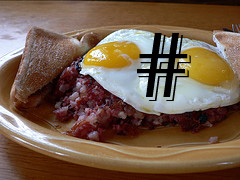Corned Beef Hashtags

Two of my favorite things are corned beef and hashtags. Corned beef is obvious… it’s in my blood (seriously… my doctor calls it cholesterol). As for hashtags, anyone who has followed my exploits on Twitter (@DrDigipol) or heard me speak on the topic knows I am a big advocate for the strategic use of hashtags.
For those of you who don’t live on Twitter, a hashtag is any string of characters immediately following the “#” in a tweet. Twitter recognizes the # and turns the character string into a search query link. So, #OWS would create a link to search for tweets using that hashtag to talk about Occupy Wall Street issues (also #OccupyWallSt, #OccupyWallStreet, etc.).
In the short run, hashtags serve to aggregate conversations. Used over the long run, they become de facto groups on Twitter. Unlike setting up groups on Facebook, there is no registration process (and hence, no actual group ownership). Simply adding the # to a string of characters makes it a hashtag.
For popular hashtags, like #p2, which organizes the progressive community on Twitter, or #tcot (“top conservatives on Twitter”), there may be hundreds of thousands of people using them on any given day. This means that someone launching a new Twitter account with zero followers can use a couple of key hashtags and put their first tweet in front of a huge audience. There is no other free distribution channel you can control to do this. Online ads cost money and popular news media sites and blogs are editorially controlled by other people. Twitter reigns supreme here.
I usually follow a simple process to identify what hashtags to use for any given tweet or set of tweets. First, I do a few keyword searches on Twitter related to the topic of my tweets. I look for what hashtags people tweeting on this topic are using. Then I test a few of those found hashtags and obvious keywords turned into hashtags to see which are most commonly used.
A busy hashtag is used every minute or so. A moderately busy hashtag is used a few times an hour. And a slow hashtag is used a few times a day or less.
Ideally, I want to reach the people using the busiest hashtags. But these are also the noisiest streams, so breaking through is hard. Moderately busy hashtags are easier to get noticed using, but the reach is smaller than the busiest. That is why I often pair one of each together. My hope is to get people from the moderate hashtag stream to RT me into the busiest hashtag stream.
In addition to looking at how frequently a hashtag is used, I look to see how diverse the people using it are. If the icons down the left side of the search results are all, or mostly, different people, then it is a good sign. If the icons are all the same person or two people, the hashtag is a a vanity tag or a small conversation.
The last trick to assess the best hashtag comes from my former intern @QueenOfBlah. Take your best hashtags based on frequency and diversity and count how many tweets have used each over the past 3 hours. Then count how many of those tweets are retweets, The hashtag with the highest ratio of retweets to tweets in that fixed, common time period is your best tag. Why? Because it taps into a community highly likely to share your tweets.
And that is your primary goal.
Then commence establishing your presence in your chosen hashtag communities. Remember, this is a social media, so if you expect other people to retweet you, you must rewteet them. Find tweets you agree with and retweet them. Find tweets you disagree with and retweet with a comment preceding “RT.” Now you are engaging. Now people will be more likely to retweet your good tweets.
If you want to establish a new hashtag, be sure to pair it with other related, ESTABLISHED hashtags. That ensures people know you are trying to establish a new hashtag. Also, be sure to define your hashtag on TagDef.com. TagDef.com will allow you to tweet out your new definition. Don’t forget to do that. For an example, see a pair of definitions I applied to the hashtag #coward. Note that TagDef.com is a crowd-sourced dictionary, so give your definition a big “thumbs up.”
A couple final tips for using hashtags strategically:
That should get you started. Now, would someone please pass the ketchup.




